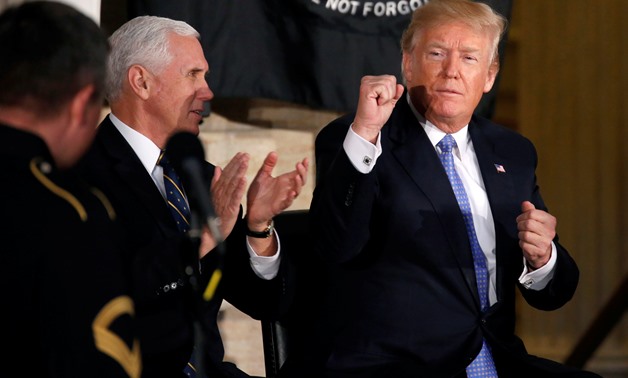
U.S. President Donald Trump and U.S. Vice President Mike Pence applaud a singer during for a Congressional Gold Medal ceremony honoring former Senate majority leader Bob Dole (R-KS) on Capitol Hill in Washington, U.S., January 17, 2018. REUTERS/Joshua Rob
CAIRO – 6 May 2018: U.S. President Donald Trump is expected to announce on May 12 his country’s withdrawal from the Joint Comprehensive Plan of Action (JCPOA), known in as P5+1, which was concluded by former President Barak Obama’s administration with Iran in 2015.
After studying the JCPOA’s detailed provisions, Egypt Today sums up the whole Trump-Iran story in this article. The U.S. can unilaterally withdraw from the Iran nuclear deal, but it must seek an agreement by other members of the P5+1.
Media reports anticipated that Trump may claim that Iran is not complying with the nuclear deal, despite numerous IAEA reports to the contrary and his own two previous certifications of the deal.
John Bolton draft-plan to exit the deal
John R. Bolton, who was appointed as U.S. national security advisor on April 9, wrote way-out scenario months ago, offering his vision to the Trump administration to abrogate the deal.
Under the title “How to Get Out of the Iran Nuclear Deal”, Bolton, who was then a former U.S. ambassador to the United Nations and a senior fellow at American think-tanks, drew up the plan for Trump to leave the Iran deal.
The Trump administration has repeatedly accused Iran of violating the “spirit” of the agreement, in references to the preamble and Article 28 of the JCPOA. According to Bolton’s scenario, the U.S. believes Iran is a grave threat to the U.S. and its allies, particularly Israel. “We can bolster the case for abrogation by providing new, declassified information on Iran’s unacceptable behavior around the world,” Bolton revealed.
“The Administration should announce that it is abrogating the JCPOA due to significant Iranian violations, Iran’s unacceptable international conduct more broadly, and because the JCPOA threatens American national-security interests,” Bolton added.
He also demonstrated the Iran deal’s disadvantages to the Gulf states, adding that the link between Iran and North Korea must be illustrated, too. Indeed, a historic summit between Trump and the North Korean leader is expected to take place within weeks.
Bolton sums up his exit scenario in key four points. First is the U.S.’s consultation with the U.K., France, Germany, Israel and Saudi Arabia. Secondly, a detailed “white paper” is prepared to explain the Iranian threats to U.S. national interests.
Thirdly, Bolton proposes launching a diplomatic campaign in Europe and the Middle East to emphasize Iran’s threat as a top priority. Finally, diplomatic efforts must be exerted to build support domestically and externally for the American abrogation of the deal.
Trump’s legal options to exit Iran deal
In March, Brian Hook, senior policy advisor to the U.S. secretary of state, characterized the JCPOA as a “sui generis nonproliferation plan of action” that is a political document. “As a political document, the president has the authority to withdraw from it,” he said.
Trump has to certify every 90 days that Iran is in compliance with the terms of the agreement. Yet, he recently refused to recertify it, in preparation for a final withdrawal, as he has reaffirmed on many occasions.
According to the U.S. constitution and the JCPOA, a Trump refusal to certify the deal would pass the issue over to the Congress, which would then have to decide within 60 days whether or not to re-impose nuclear-related economic sanctions on Iran.
From Iran’s point of view, if sanctions are re-imposed by the U.S., then this would be deemed a material breach of the deal.
According to the JCPOA provisions, the U.S. and Iran could raise their dispute issues before the Joint Commission, which shall oversee the implementation of the deal. The Joint Commission would then have the opportunity to resolve the problem, at both the foreign minister level and through a three-member advisory panel.
The U.S. would have to notify the U.N. Security Council of its assessment that Iran is in non-performance. As a result, the UNSC would then have to vote on a resolution to continue sanctions relief. The Trump administration would likely veto the resolution and the pre-JCPOA U.N. sanctions against Iran would be back in place.
Iran’s reaction to Trump’s deal withdrawal
The U.S. refusal of recertify the deal gives Iran grounds to cease performing its own commitments. This would see Iran expand its nuclear program to pre-agreement levels and even beyond.
EU Foreign Policy Chief Federica Mogherini said, “We already have one potential nuclear crisis. We definitely [do] not need to go into another one,” in reference to a potential proxy war between the U.S. and Iran in the Middle or Far East, including the Korean Peninsula.
According to a report published by the American magazine Foreign Policy, Iran would return to its past levels of uranium enrichment now that it is in possession of hundreds of billions of dollars that were released to Tehran under the deal.


Comments
Leave a Comment